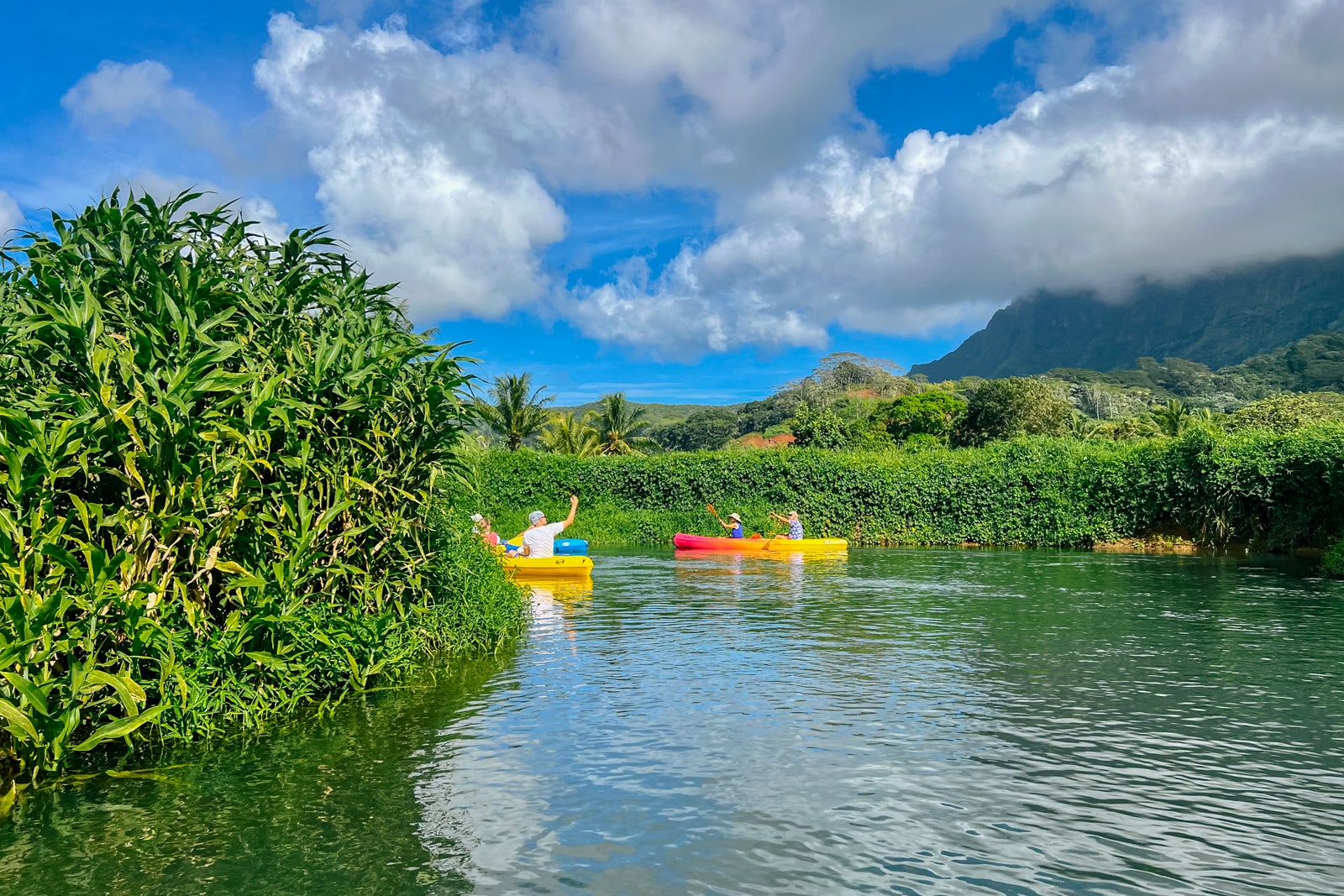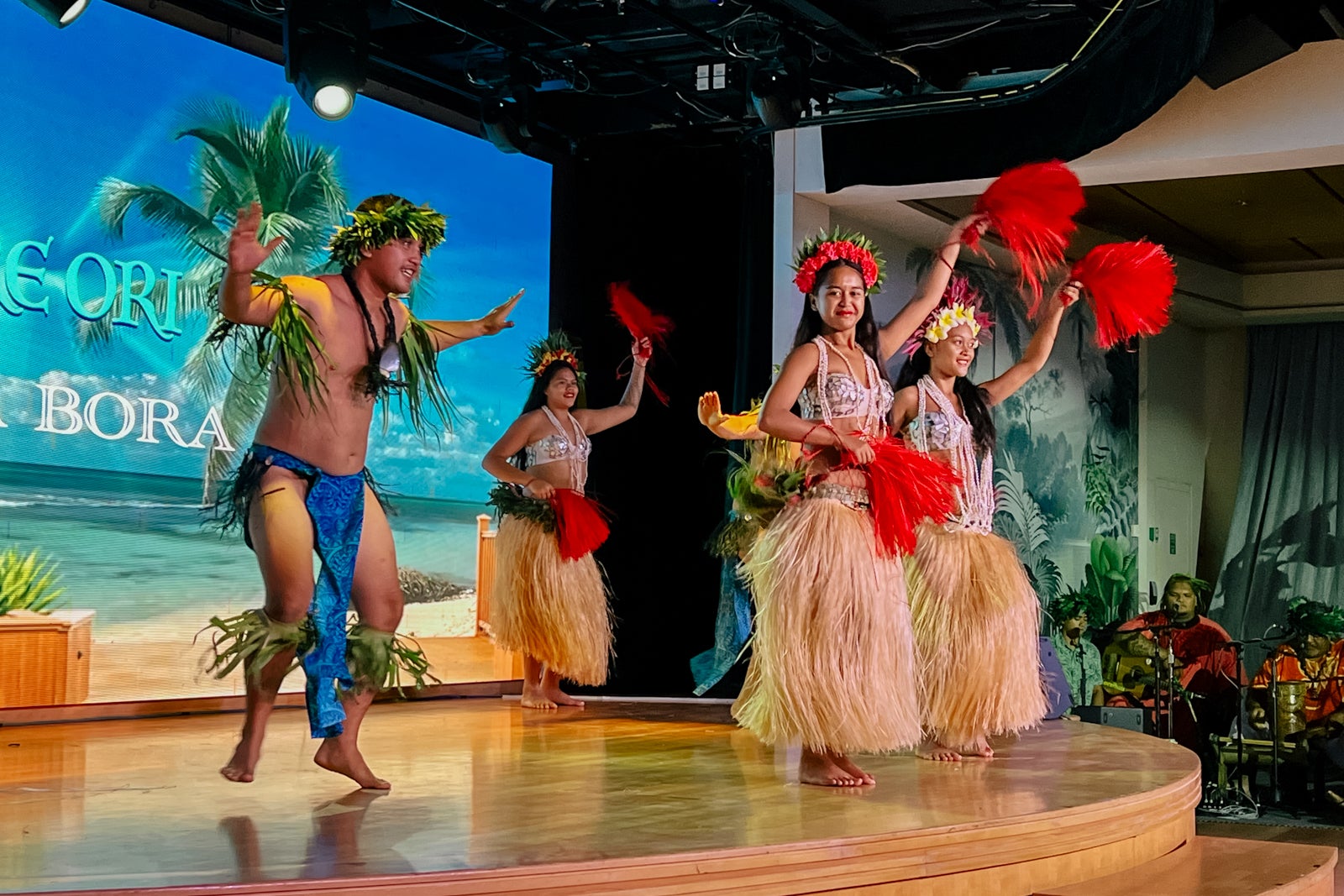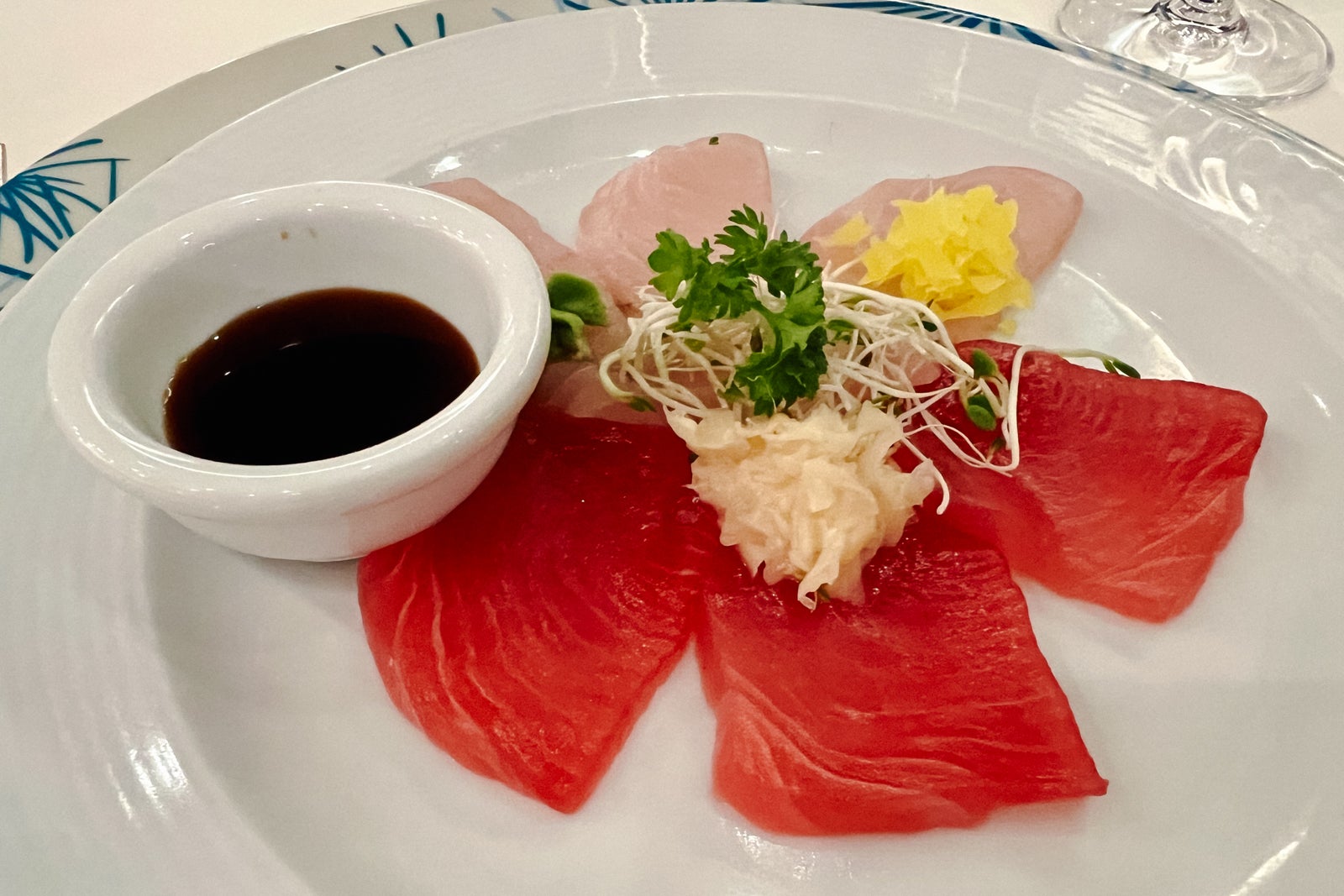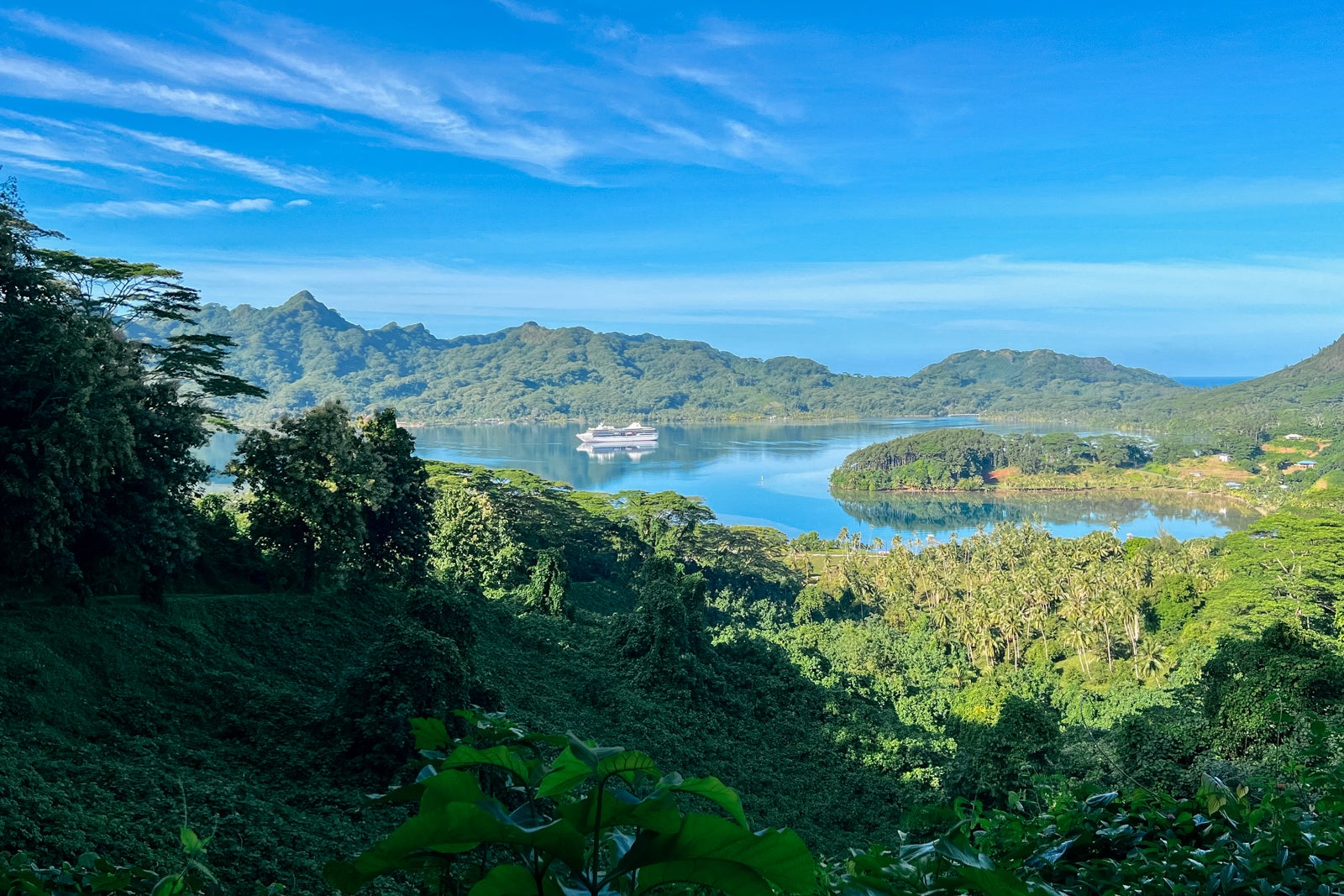I was five days into a seven-day voyage on the French Polynesia-based Paul Gauguin when the wild thoughts began.
Do I really have to go back? Couldn’t I just stay here forever?
Lounging by the pool on the 330-passenger Paul Gauguin Cruises vessel as it sailed between Bora Bora and Moorea, two of the most stunning islands you’ll ever see, I started doing the mental math. What if I sold my home back in North Carolina? What if I cashed out my IRA? Could I afford to stay on board cruising these islands in perpetuity?
It was that beautiful. That peaceful. That … je ne sais quoi, but I knew I just wanted to stay.
And, yes, I was starting to lace my sentences with French phrases, like they do on board Paul Gauguin and across the islands it visits. I had the bug. Just like the namesake of the 330-passenger ship, the celebrated post-impressionist painter Paul Gauguin, who famously fled Europe in the 1890s to seek a simpler life here. And Fletcher Christian, the English naval officer who led the mutiny on the British ship HMS Bounty in 1789 so he never had to leave.
In the end, I did get off the ship two days later and returned home. There was no mutiny on The Gauguin. But only reluctantly. And I’m already plotting my return.
Idyllic weather, stunning scenery
To sail on The Gauguin, as Paul Gauguin Cruises likes to call its vessel (and the line only has one vessel), is to be on an endless loop of the greatest hits of tropical island beauty.
Tahiti, Huahine, Raiatea, Tahaa, Bora Bora, Moorea. On the ship’s weeklong itineraries they come one after another, without a single day of sailing in between. You leave one at sunset — invariably a beautiful sunset — and arrive at the next as the sun rises.
In between, you have full days free to explore each of the islands’ particular brand of South Pacific paradise.
Daily Newsletter
Reward your inbox with the TPG Daily newsletter
Join over 700,000 readers for breaking news, in-depth guides and exclusive deals from TPG’s experts
On Huahine, for me at least, that meant snorkeling in the incredibly clear lagoon, where I was dazzled by the neon-bright clams atop coral clusters and all sorts of colorful fish. I also snuck a peek at the ancient Polynesian temples (marae) — Huahine is particularly known for its temples — and ogled the famed blue-eyed eels.
1 of 5
TPG’s Gene Sloan getting ready to snorkel in Huahine’s lagoon. GENE SLOAN/THE POINTS GUY
The next day, on Raiatea, it meant kayaking the only navigable river in French Polynesia, the Faaroa. If you want to kayak in French Polynesia, this is the place.

In Bora Bora, it meant swimming with sharks and stingrays. (Yes, you can swim with sharks and stingrays in Bora Bora.)
The backdrop for all this was the loveliest rainforest-covered volcanic mountains that you’ll ever see. The islands are also ringed with sandy beaches, turquoise water and little palm-lined islets — which is to say, they are stunning.
And I haven’t even mentioned the idyllic weather yet. It’s not perfectly-sunny-365-days-a-year weather, mind you. Lush rainforests aren’t created by all-day sun; clouds and downpours are regular occurrences. But the climate is unfailingly warm and tropical, with cooling breezes that sometimes carry the soothing scent of tiare and frangipani flowers or, if you’re on Tahaa, the sweet and intoxicating aroma of vanilla beans.
A French Polynesia experience like no other
There are many ways to visit French Polynesia, of course. Many visitors head straight to a resort on Tahiti, Bora Bora or Moorea — arguably the three most iconic islands of the entire South Pacific — and never leave. All three islands are known for resorts with overwater bungalows, where the whole idea is pretty much that you’ll check in and never venture much further than the crystal-clear waters just outside your door.
For those who can afford one, an overwater bungalow is the de rigueur way to stay in this part of the world.

There are also other cruise lines besides Paul Gauguin that offer sailings to French Polynesia (though not as many as you might think). But with its one vessel, which is based in French Polynesia year-round, Paul Gauguin offers a South Pacific experience that is unlike any other.
A sailing on The Gauguin is, for starters, one of the only ways you can visit a wide range of French Polynesian islands in one trip without the costs and logistical hassles that come with island-hopping by airplane.
Related: Why your next dream vacation should be this luxury island cruise
Only one other cruise brand, Windstar Cruises, bases a small ship in the region that visits as many islands as Paul Gauguin (if you don’t count the company that operates Arunai 5, the odd-looking French Polynesian cargo ship with passenger cabins).
But Paul Gauguin is also interwoven into the local community like no other cruise vessel — and thus offers a special charm.

Built specifically to sail in French Polynesia and, for most of its 28-year history, owned by a local company (it was acquired by France-based Ponant Explorations in 2019), it is staffed with far more local residents than is typical for cruise ships, in roles ranging from the receptionist at the guest relations desk to the ship’s nurse.
Among the most charming aspects of the ship is the presence of the Gauguins and Gauguines — locals who live aboard the ship as hosts and entertainers with a mandate to bring the spirit of French Polynesia to life. I loved watching them interact with passengers, whether it was teaching dances, ukelele lessons or how to tie a pareo (French Polynesia’s version of a sarong).
On the once-a-sailing “Polynesian Night,” when passengers were encouraged to show up in their most Polynesian-inspired attire, the Gauguins and Gauguines were there to help apply temporary tattoos. On several nights, they performed traditional songs and dances in the vessel’s main theater.

As I saw on several of my outings, The Gauguin also has longstanding relationships with locals who operate many of the tours it offers during island stops. As a result, these tours often have the feel of a resident showing you around her or his home. I loved that my guide in Huahine, who toured us around in an open-air truck with room for eight people, stopped to show us the fish trap that his family personally used for catching dinner.
In addition, the food on board is often locally sourced, with the ship’s head chef leaving the vessel in the morning to pick up fresh fish for that night’s dinner — whatever the fishermen have just brought in. I experienced this firsthand several nights, feasting on lovely fresh-caught yellowfin tuna (served all sorts of ways, from sashimi and tartare to grilled), mahi-mahi and Ray’s bream (which the locals call papio) at the ship’s restaurants.

In short, a sailing on The Gauguin feels more like a stay at a locally-owned boutique hotel than a voyage on an international cruise ship.
An overwater bungalow that sails
No doubt aware of just how popular overwater bungalow resorts are in French Polynesia, Paul Gauguin’s marketing team are fond of saying The Gauguin is “an overwater bungalow that sails.” It’s a slick slogan, for sure. But on some level, it’s true.
Nearly every morning of my sailing, I swept open the drapes of my cabin to find a completely new, spectacular view that invariably included an expanse of pristine water backed by stunning mountains. In Huahine, we were anchored smack in the middle of Maroe Bay, considered one of the most beautiful bays in French Polynesia. No hotel on the island offers as good a view. In Bora Bora, we anchored just off the town of Vaitape, within the picture-perfect lagoon that has made the island so famous.

Unveiled in 1997, The Gauguin is on the older side when it comes to upscale cruise vessels sailing the globe. Its cabins lack some of the trappings of the latest luxury ships, like bedside USB ports or marble-lined walk-in showers in bathrooms. But a major refurbishment in recent years has left these cabins looking bright and airy, with a comfortable and up-to-date feel — and the ship’s public areas have also been kept up-to-date over the years with regular overhauls, including a major one just a few months ago.
Related: Paul Gauguin Society cruise loyalty program: Everything you need to know
What the ship lacks in newness, moreover, is canceled out at some level by some of its “they don’t make them like this anymore” features. I particularly loved the wide-open decks atop the ship — decks that were much more open than you’ll typically find on a newer ship this size. I regularly headed up to the spacious front area of the top deck at sailaway for the uncluttered, 270-degree view. On a more modern ship, this space surely would be busied up with “attractions” like putting greens or a pickleball court that would just take away from the expansiveness.
Access to a private islet
In addition to onboard activities, passengers on every Paul Gauguin sailing have the opportunity to spend a day lounging at the line’s very own private islet — or motu, as they’re called in the South Pacific.
Called Motu Mahana, this private islet is located just off the French Polynesian island of Tahaa, close to Bora Bora, and it’s yet one more standout feature that makes these trips so special.
1 of 4
Lounge chairs overlooking the shallow lagoon at Motu Mahana. GENE SLOAN/THE POINTS GUY
Appearing on every Paul Gauguin itinerary (usually as a day stop just before the ship visits Bora Bora), Motu Mahana is home to a palm tree-lined beach and warm shallow waters for swimming, snorkeling and kayaking.
On the Motu Mahana day of each cruise, pretty much everyone heads off the ship, which anchors nearby, for a full day of beachy fun that includes a beach barbecue, volleyball games, traditional music and dancing by the Gauguins and Gauguines, and a range of hands-on activities.
An all-inclusive getaway
Paul Gauguin sailings aren’t cheap. The seven-night More Society Islands and Tahiti sailing I did typically starts at close to $4,000 per person. That works out to a bit over $1,000 per night for a couple sharing a room.
Some of the line’s longer, more off-the-beaten-path sailings, such as its 14-night Marquesas, Tuamotu, and Society Islands trips, can cost significantly more in total — although on a per-day basis, the pricing is similar.
Related: The 5 best destinations you can visit on a Paul Gauguin Cruises ship
The starting prices mentioned above are for entry-level cabins on sailings during the offseason. As is typical for cruises everywhere, pricing is higher for bigger cabins and for sailings during peak season periods, such as around the winter holidays.
Still, as is customary for cruise lines at the high end, Paul Gauguin includes a lot in its base price. In addition to a room on board and all meals, the fares include most drinks on board, shipboard Wi-Fi and gratuities.
Bottom line
The 330-passenger Paul Gauguin is something of a unicorn in the world of cruising — a one-of-a-kind vessel built specifically to sail in the far-from-almost-everywhere waters of the South Pacific. It is there that it began its life nearly 30 years ago, and it is there that is has remained all these years, on a seemingly endless loop between some of the best-known and most beautiful tropical islands found anywhere in the world.
If you’re eager to see the islands of South Pacific (particularly the corner of the South Pacific that is French Polynesia) and you don’t want to be restricted to visiting just one or two places, it’s a great vacation choice.
Planning a cruise? Start with these stories:
Source link

















Add Comment